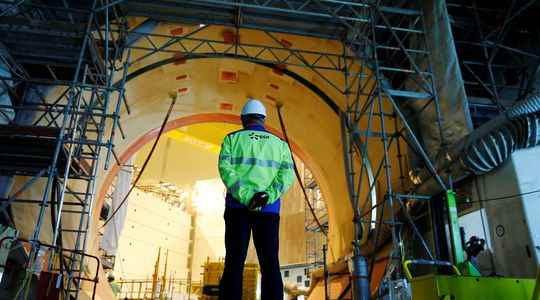To resume “the thread of the great adventure of civil nuclear power in France”, in his words, Emmanuel Macron is betting on a new model of EPR (European pressurized reactor). Traveling to Belfort on Thursday, the Head of State announced the construction of six EPR2 and studies for the prospect of building eight more. “We are going to start the preparatory projects in the coming weeks”, continued the president, who hopes to start work by 2028 and first commissioning in 2035. An “interministerial program management” will be created to monitor the progress of projects. If Emmanuel Macron has promised “massive public funding of several tens of billions of euros”, are EPR2s really less expensive than “classic” EPRs?
Built in pairs
France is currently only building an EPR on its territory, in Flamanville, in the Manche department. It is also the only reactor under construction in France since 1991. Work began in 2007 for commissioning initially planned… five years later. Estimated amount: 3 billion euros. The calendar and the note have since fallen from the hands of EDF, the project leader. On January 12, the group announced that the date for loading fuel into the tank of the future reactor – prior to any operating test – is “shifted from the end of 2022 to the second quarter of 2023”. “The estimate of the cost at completion goes from 12.4 billion euros to 12.7 billion”, added EDF. An amount called “overnight” – as if the plant had been built in a single night – which does not, however, include the financial interests linked to the project. In a report published in June 2020, by the Court of Auditors, the full cost of the project was estimated at 19 billion euros. The construction of the Flamanville EPR represented, for her, “an operational failure, cost drifts and considerable delays”.
With the EPR2, Emmanuel Macron hopes to avoid such setbacks. EDF, which launched the development of this high-power pressurized water reactor in 2015, presents them as simpler and cheaper to build. The energy group obviously intends to benefit from the feedback from the three EPRs (two in Taishan, one in Olkiluolto in Finland) already built around the world as well as that of Hinkley Point in the United Kingdom. But also a series effect – the EPR2s being built in pairs. The electrician stresses that these are the first reactors “to be completely designed in a digital way”, allowing better detection of anomalies. These optimizations on the method of construction “will make it possible to make economies of scale”, assures EDF, already heavily indebted and whose State is the majority shareholder. The group submitted to the government, in the spring of 2020, a proposal to build six EPR2s (three times two, therefore) on existing sites: in Penly (Seine-Maritime), then in Gravelines (North) and, finally, in Bugey ( Ain) or Tricastin (Drôme).
“Consequences until the 22nd century”
Despite EDF’s assurance of the savings made with this programme, the Court of Audit, again she, still in 2020, warned of the “major financial challenge” of these constructions, which she estimated at 46 billion euros. “The decision whether or not to build future EPRs will have consequences well into the 22nd century,” she wrote. The example of Flamanville surely in the lead, the magistrates reported, more recently, an “uncertainty in terms of ability to build a new fleet of reactors in a timely manner and at reasonable costs”.
The proof: in a summary note from the Treasury called “New French nuclear power”, dated September 2020 and published by context, the construction cost of six EPR2s is estimated at 47.2 billion. The first pair would be worth 16.4 billion euros; the second at 15.9 billion euros; the third at 14.9 billion euros. However, still according to context, a government working document, dated October 2021, rather expected a range between 52 and 57 billion euros in a scenario of “good industrial control”. In a “more degraded” scenario, the cost would even reach 64 billion euros. The document specifies that “strong uncertainties still weigh on the program’s cost forecast” and that EDF’s costing does not include “all the possible additional costs”.
Uncertain date of commissioning
Regarding the commissioning, Emmanuel Macron seems more optimistic than the administration is in its working document. The president hopes for the commissioning of a first EPR2 by 2035; rather “2039-2040, for a scenario of relatively good industrial mastery”, is it written. If the delays and problems accumulate, it will be more 2042-2043, “even after 2045 in severely degraded scenarios”.
There is also the question of funding. The President assured that the State will take its share, therefore, via public funding. Will he also use the recent – and disputed – integration of the atom in the green taxonomy of the European Union to finance the EPR2? It is probably with this objective in mind that France weighed in so that nuclear power appears on this list.
